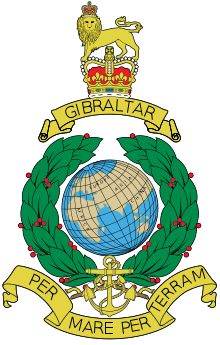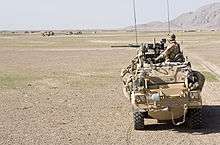3 Commando Brigade
3 Commando Brigade is a commando formation of the British Armed Forces and the main manoeuvre formation of the Royal Marines. Its personnel are predominantly Royal Marines, supported by units of Royal Engineers, Royal Artillery, and the Fleet Air Arm, together with other Commando Qualified sailors, soldiers and airmen.
| 3rd Special Service Brigade 3rd Commando Brigade 3 Commando Brigade | |
|---|---|
 Cap Badge of the Royal Marines | |
| Active | 14 February 1942–present |
| Country | |
| Branch | |
| Type | Marines Commando Light infantry |
| Role | Commando/Amphibious Landing Force |
| Size | 8 battalions |
| Garrison/HQ | HQ - Stonehouse Barracks, Plymouth |
| March | Quick - Sarie Marais |
| Engagements | Second World War
Operation Musketeer |
| Commanders | |
| Brigade Commander | Brigadier Matt Jackson DSO |
| Insignia | |
| 3 Commando Brigade Formation Badge |  |
The brigade was formed in 1942, during the Second World War, with a mixture of Army commando and Royal Marine commando units and served in the Burma Campaign. After the Second World War, the Army commandos were disbanded and the brigade became a Royal Marine formation. Recently, the brigade has again become a mixed Army and Marine formation with the addition of an Army infantry battalion, artillery regiment and engineer regiment alongside three Royal Marine battalions and support services. Since the end of the Second World War, it has served in the Suez crisis, Falklands War, Gulf War and the War in Afghanistan.
History
Second World War
Between September and November 1943, in Scotland, 102nd Brigade, Royal Marines Division was detached from the division, to form the independent 3rd Special Service Brigade – a joint British Army-Royal Marines formation. The founding commander was Brigadier Wilfrid Nonweiler and it was composed of the following units:[1][2]
- No. 1 Commando (British Army);
- No. 5 Commando (British Army);
- No. 42 Commando (Royal Marines), and;
- No. 44 Commando (Royal Marines).
Nos. 1 and 5 Commandos had already earned battle honours as units in, respectively, the North African and Madagascar campaigns. Because "Commando", at the time, implied a company/battalion-sized unit, the name "Special Service" was instead used for British commando brigades. (However, the term "Commando Brigade" was often used informally, because "Special Service" was unpopular and had a superficial similarity to the name of the already-notorious German SS.) The brigade was later officially renamed 3rd Commando Brigade.[3]
On 10 November 1943, elements of the brigade embarked at Gourock, bound for India. It was intended that the brigade would be used in operations against Japanese forces in the South-East Asia theatre, such as the Burma campaign.[4] However, the limited shipping capacity available at the time meant that the relocation was prolonged and the components of the brigade were not reunited until late 1944. Lt Col. Peter Young was transferred from the Normandy campaign to become 2IC of 3rd Commando Brigade. Young would later succeed Nonweiler as commander of the brigade.
During January 1945, the brigade was involved in the campaign to recapture Arakan, including the battles of Myebon peninsula and Kangaw.[4] The brigade was then withdrawn to India to prepare for a proposed amphibious operation to recapture the Malayan peninsula. However, the use of atomic bombs against Japan precipitated an earlier surrender of Japan than expected.[4] Instead, the 3rd Commando Brigade moved to secure Hong Kong – a British crown colony that was under Japanese occupation in 1941–45.[4]
During 1946, British Army personnel and units within the 3rd Commando Brigade were demobilised or transferred elsewhere, and it became, in effect, a Royal Marine formation.[4]
Post Second World War
3 Commando Brigade's most high-profile operation after the war was the Suez Crisis, when it took part in the amphibious assault against Egyptian targets. During Operation Musketeer, units of the brigade made a helicopter-borne assault.[5]
1971 saw the withdrawal of British forces from the Far East and Persian Gulf. The brigade returned to the UK with other British units. It moved to Stonehouse Barracks in Plymouth, where it remains to this day.[6] The brigade was deployed to Northern Ireland as part of Operation Banner as violence escalated during the Troubles in July 1972.[7]
Operation Corporate
The brigade's next large operation was in 1982. Argentina invaded the Falkland Islands, and 3 Commando Brigade, reinforced by 2 Para and 3 Para, was one of the two main British land formations that took part in operations to recapture the islands. The brigade landed at San Carlos Water and marched across East Falkland to Stanley. Argentine units were defeated in several sharp engagements, and their forces surrendered on 14 June.[8]
Gulf War
In the aftermath of the 1991 Gulf War, the brigade was deployed on a non-combat task in northern Iraq. The Iraqi Kurds had suffered immensely during the war and in its immediate aftermath, and the brigade was used due to its rapid deployment ability. It provided humanitarian aid to the Kurds and saved many from starvation.[9]
21st century
Recently, the brigade has been involved in two major campaigns, including Operation Veritas in Afghanistan, 2001 and 2002, and Operation Telic during the 2003 invasion of Iraq. In Afghanistan, no contact was made with enemy forces, despite contrary predictions. Iraq, however, saw heavy fighting occur in the early stages of the campaign, as the brigade made its first amphibious assault in over 20 years by landing on the Al-Faw peninsula in south east Iraq.[10] In 2006, the brigade returned to Afghanistan on Operation Herrick, replacing 16 Air Assault Brigade, where intense fighting occurred.[11] From 2008 to 2012 1st Battalion, The Rifles was one of the attached army units in 3 Commando Brigade.
Organization
The brigade contains Royal Marines, Royal Navy, Army and Royal Air Force personnel. The subordinate units are:[12]
- 30 Commando Information Exploitation Group (Royal Marines), Stonehouse Barracks
- Royal Marines Armoured Support Group (Royal Marines), Royal Naval Air Station Yeovilton
- 539 Raiding Squadron (Royal Marines), HMNB Devonport
- 40 Commando (Royal Marines), Norton Manor Camp
- 42 Commando (Royal Marines), Bickleigh Barracks
- 45 Commando (Royal Marines), RM Condor
- 43 (Fleet Protection Group) Commando (Royal Marines), HMNB Clyde
- 47 Commando (Raiding Group) Royal Marines
- 29th Commando Regiment, Royal Artillery (Royal Artillery), Royal Citadel, Plymouth
- 24 Commando Royal Engineers (Corps of Royal Engineers), RM Chivenor
- Commando Logistic Regiment, Royal Logistic Corps (Royal Logistic Corps and Royal Marines), RM Chivenor
When operating as part of the combined United Kingdom / Netherlands Landing Force, the 1st Marine Combat Group of the Dutch Korps Mariniers is also attached to the brigade.
Commanders
Commanders have included:[13]
- 1943–1944 Brigadier Peter Young
- 1944–1945 Brigadier Campbell Hardy
- 1948–1951 Brigadier Campbell Hardy
- 1951–1952 Brigadier Cecil Phillips
- 1952–1954 Brigadier James Moulton
- 1954–1955 Brigadier Ian Riches
- 1955–1957 Brigadier Reginald Madoc
- 1957–1959 Brigadier Robert Houghton
- 1959–1960 Brigadier Peter Hellings
- 1960–1962 Brigadier Norman Tailyour
- 1962–1964 Brigadier Francis Barton
- 1964–1965 Brigadier Leslie Marsh
- 1965–1966 Brigadier Anthony Willasey-Wilsey
- 1966–1968 Brigadier Ian Gourlay
- 1968–1970 Brigadier Peter Whiteley
- 1970–1972 Brigadier Patrick Ovens
- 1972–1975 Brigadier Roger Ephraums
- 1975–1977 Brigadier John Richards
- 1977–1979 Brigadier Jeremy Moore
- 1979–1981 Brigadier Michael Wilkins
- 1981–1983 Brigadier Julian Thompson
- 1983–1984 Brigadier Martin Garrod
- 1984–1986 Brigadier Henry Beverley
- 1986–1988 Brigadier Robin Ross
- 1988–1990 Brigadier Andrew Whitehead
- 1990–1992 Brigadier Andrew Keeling
- 1992–1994 Brigadier David Pennefather
- 1994–1995 Brigadier Jonathan Thomson
- 1995–1997 Brigadier Anthony Milton
- 1997–1998 Brigadier Robert Fulton
- 1998–1999 Brigadier David Wilson
- 1999–2001 Brigadier Robert Fry
- 2001–2002 Brigadier Roger Lane
- 2002–2004 Brigadier James Dutton
- 2004–2006 Brigadier John Rose
- 2006–2007 Brigadier Jeremy Thomas
- 2007–2008 Brigadier David Capewell
- 2008–2008 Brigadier Buster Howes
- 2008–2009 Brigadier Gordon Messenger
- 2010–2011 Brigadier Ed Davis
- 2011–2013 Brigadier Martin Smith
- 2013–2014 Brigadier Stuart M. Birrell
- 2014–2015 Brigadier Charles Stickland
- 2015–2017 Brigadier Jim Morris
- 2017–2018 Brigadier Gwyn Jenkins
- 2018–Present Brigadier Matt Jackson[14]
Battle honours
The following Battle honours were awarded to the British Commandos during the Second World War.[15][16]
- Vaagso
- Norway 1941
- St. Nazaire
- Dieppe
- Normandy Landing
- Dives Crossing
- Flushing
- Westkapelle
- Rhine
- Leese
- Aller
- North-West Europe 1942 '44–45
- Litani
- Syria 1941
- Steamroller Farm
- Sedjenane 1
- Djebel Choucha
- North Africa 1941–43
- Landing in Sicily
- Pursuit to Messina
- Sicily 1943
- Landing at Porto San Venere
- Termoli
- Salerno
- Monte Ornito
- Anzio
- Valli di Comacchio
- Argenta Gap
- Italy 1943–45
- Greece 1944–45
- Crete
- Madagascar
- Adriatic
- Middle East 1941 '42 '44
- Alethangyaw
- Myebon
- Kangaw
- Burma 1943–45
See also
- British Commandos
- British military history
- Ski warfare
- Military of the United Kingdom
- 1st Commando Brigade
- 2nd Commando Brigade
- 4th Commando Brigade
- Australian commandos
- Marine Expeditionary Brigade American equivalent
- Netherlands Marine Corps Dutch equivalent and part of UK/NL Landing Force
References
Citations
- "burmastar". Archived from the original on 5 July 2008. Retrieved 6 August 2008.
- Chappell 1996, p. 28.
- Moreman 2008, p. 32.
- Chappell 1996, p. 31.
- "1956: Allied Forces take control of Suez". BBC. Retrieved 4 April 2016.
- "3 Commando Brigade". British Army units 1945 on. Retrieved 4 April 2016.
- Van der Bijl 2009, p. 68
- "3 Commando Brigade". Naval History.net. Retrieved 4 April 2016.
- "1991: UK forces withdraw from Kurdish haven". BBC News. 14 July 1991. Retrieved 10 October 2008.
- "Marines spearhead the invasion with lightning attack". The Telegraph. 21 March 2003. Retrieved 4 April 2016.
- "Commandos ready to face the Taliban". BBC. Retrieved 4 April 2016.
- "3 Commando Brigade". Royal Navy. Retrieved 4 April 2016.
- Royal Navy Senior Appointments Archived 11 July 2011 at the Wayback Machine
- "3 Commando Brigade change over". January/February Edition. 14 February 2019.
- Moreman, p.94
- "Commando Forces at regiments.org by T.F.Mills". Archived from the original on 7 November 2007. Retrieved 2015-07-14.
Sources
- Chappell, Mike (1996). Army Commandos 1940–1945. Elite Series # 64. London: Osprey Military Publishing. ISBN 1-85532-579-9.
- Moreman, Tim (2008). British Commandos 1940–46. Battle Orders. London: Osprey Military Publishing. ISBN 978-1-84176-986-8.
- Southby-Tailyour, Ewen (2009). 3 Commando Brigade. Ebury Press. ISBN 978-0-09-192696-0.
- Neillands, Robin (2004). By Sea and Land: The Story of the Royal Marine Commandos. Barnsley: Pen & Sword Classics. ISBN 1-84415-043-7.
- Philip, Sea soldiers' readied for a new world disorder,' Jane's Navy International, September 2001
- Van der Bijl, Nick (2009). Operation Banner: The British Army in Northern Ireland 1969-2007. Pen & Sword. ISBN 978-1844159567.
External links
| Wikimedia Commons has media related to 3 Commando Brigade. |

